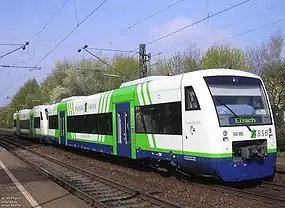Duisburg Stadtbahn
The Duisburg Stadtbahn is a light rail (German: Stadtbahn) network forming part of the larger Rhine-Ruhr Stadtbahn system. It is the centrepiece of the public transport system in Duisburg, a city in the federal state of North Rhine-Westphalia, Germany.
 | |||
 Muehlenkamp Stadtbahn station at night. | |||
| Overview | |||
|---|---|---|---|
| Locale | Duisburg, North Rhine-Westphalia, Germany | ||
| Transit type | Light rail (Stadtbahn) | ||
| Number of lines | 3 | ||
| Website | Duisburger Verkehrsgesellschaft (in German) | ||
| Operation | |||
| Operator(s) | Duisburger Verkehrsgesellschaft (DVG) | ||
| Technical | |||
| Track gauge | 1,435 mm (4 ft 8 1⁄2 in) | ||
| |||
Lines
| Line | Tracks |
|---|---|
| U79 | Meiderich Süd Bf – Duisburg Hbf – König-Heinrich-Platz – Grunewald – DU-Kesselsberg – D-Wittlaer – Kaiserswerth – Heinrich-Heine-Allee – Düsseldorf Hbf – Oberbilk S/Philipshalle – Kaiserslauterner Straße – Universität Ost/Botanischer Garten |
| 901 | Obermarxloh Schleife – Marxloh Pollmann – Beeck Denkmal – Laar Kirche – Ruhrort Bf – König-Heinrich-Platz – Duisburg Hbf – Zoo/Uni – Mülheim-Speldorf – Mülheim (Ruhr) Hbf |
| 903 | Dinslaken Bf – Du-Walsum – Marxloh Pollmann – Hamborn Rathaus – Meiderich Süd Bf – Duisburg Hbf – König-Heinrich-Platz – Hochfeld Süd Bf – Wanheimerort – Hüttenheim Schleife |
History
It was planned to build a light railway system for the most important lines, which crosses the city centre from west to east. This route was chosen, because it was the best way for the line from Mülheim an der Ruhr to Moers to run through Duisburg. But also for the line to Düsseldorf light railway tracks were planned. When the construction of Stadtbahn began, the route southwards to Düsseldorf was built first. And also the first tunnel, that was just 800 m long, was built on that line in 1970, so that four years later, in 1974, construction of the route could begin. However a failure was, that Angerbogen light railway station was built for 10.5 million €, but it would never open, as the new district that was planned to be built there, was not put up as big as it had to become for such a big station.
In 1992 city tunnel was opened for trams. So many lines got another route, which was not shorter and faster in every case. For example, the line to Düsseldorf now has to run westwards south of city centre before it gets in tunnel and runs eastwards back. In 2000 the tunnel was extended to Meiderich Bf..
Changed numbers and routes
That time also some numbers and routes of lines were changed:
| old number | new number | changed route |
|---|---|---|
| 79 | U 79 | extended to Meiderich Bf. in 2000; 2012 to Universität Ost/Botanischer Garten (Düsseldorf) |
| 901 | 901 | still operating as line 901; different route in Mülheim, because now it is running undergroung to Mülheim Hauptbahnhof |
| 904
909 |
903 | reduced to one line, so the lines to Huckingen and Laar are not in service any more |
- → For history before construction of the Stadtbahn began, look at Trams in Duisburg.
References
- Höltge, Dieter (1994). Straßen- und Stadtbahnen in Deutschland [Tramways and Stadtbahnen in Germany] (in German). Band 4: Ruhrgebiet - Von Dortmund bis Duisburg [Volume 4: Ruhr - from Dortmund to Duisburg]. Freiburg i. B., Germany: EK-Verlag. ISBN 9783882553345.
External links
![]() Media related to Stadtbahn Duisburg at Wikimedia Commons
Media related to Stadtbahn Duisburg at Wikimedia Commons
- Duisburger Verkehrsgesellschaft (in German) – official site
- Duisburg database / photo gallery and Duisburg tram list at Urban Electric Transit – in various languages, including English.




